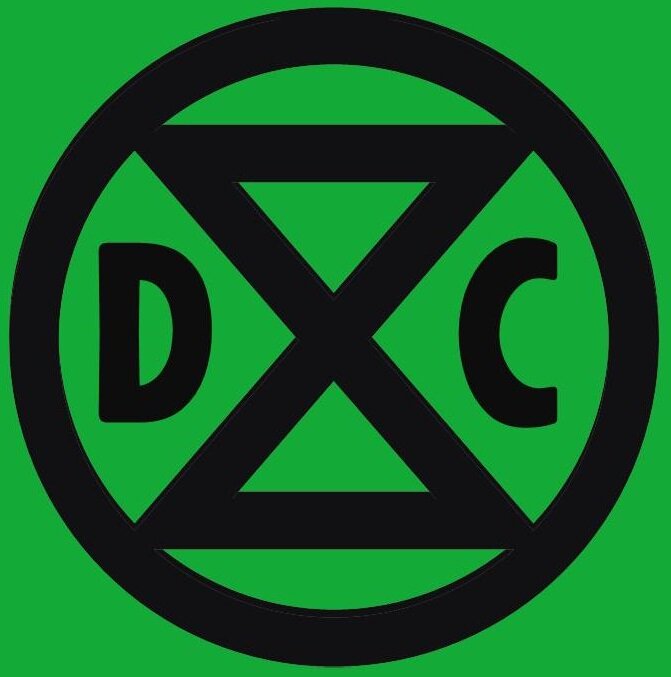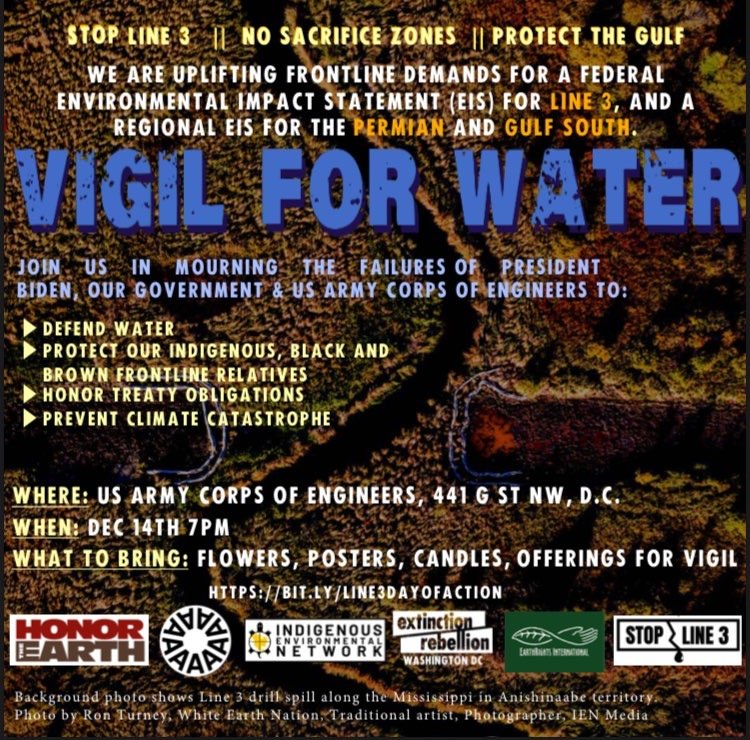JOIN US ON TUESDAY, DEC 14TH AT THE US ARMY CORPS OF ENGINEERS HQ BUILDING TO AMPLIFY FRONtLINE DEMANDS FOR ENVIRONMENTAL IMPACT STATEMENTS ON LINE 3 AND GULF COAST
Water Protectors will uplift frontline demands for a federal EIS for Line 3 and a regional EIS for the Permian and Gulf South. They will project images and footage
from Indigenous Environmental Network drone photographer Ron Turney and Honor the Earth’s media team with award-winning filmmaker Keri Pickett documenting damage already done to treaty lands and waters byEnbridge frac-outs, aquifer breaches (for which Enbridge
has been fined $3.32 million and the case referred by the state for criminal prosecution), and waste containment failures, as well as images of destruction to waters in the Gulf South.
Participants will hold a Vigil For Water, mourning “the failure of President Biden, our government, and the US Army Corps of Engineers to defend water, protect our Indigenous, Black and Brown frontline relatives, honor treaty obligations, and prevent climate catastrophe.”
Organizers include Arm in Arm, EarthRights International, Extinction Rebellion DC, Honor the Earth, Indigenous Environmental Network, and StopLine3.
Tuesday, December 14, starting 7:00 pm
U.S. Army Corps of Engineers, 441 G St. NW, Washington, DC 20314
Two federal court appeals of the U.S. Army Corps of Engineers 404 Permit on Line 3 in northern Minnesota are still awaiting decisions in Washington, DC, while Enbridge recently announced it is expanding its onward fossil fuel infrastructure capacity throughout the Gulf region in the south: federal Environmental Impacts Statements (EIS) have not been done for either region.
Now a coalition of Water Protectors are calling for a National Day of Action at select offices of the Corps around the country – including the DC headquarters – on Tuesday, December 14, 2021. Dozens of actions and letter deliveries are planned nationwide.
Pipelines are connected. So are the movements for justice. Urgently needed now, as the planet has been issued a CODE RED in the latest UN Intergovernmental Panel on Climate Change (IPCC) report, are:
A federal Environmental Impact Statement for Line 3
A regional Programmatic Environmental Impact Statement for the Permian and Gulf South
BACKGROUND – LINE 3 AND THE GULF COAST
As Line 3 runs tar sands oil from Alberta, Canada, across Minnesota to Wisconsin, leaving three known breached aquifers and at least 28 toxic frac-outs in its path, plus countless treaty violations and over 1,000 arrests, Enbridge has announced plans to further expand the capacity of its infrastructure systems connecting to the Texas Gulf Coast. Proposals include building a pipeline from the Houston area to the Port of Corpus Christi over 200 miles away, where the Canadian oil giant recently acquired the Ingleside Energy Center – the largest crude-exporting hub in the United States.
“Returning the line to full capacity sets us up for downstream expansion to the US Gulf Coast,” Enbridge CEO Al Monaco told Platts, referring to Line 3 and Southern Access expansions, promoting “full path access for Canadian [tar sands] to the US Gulf Coast.”
In response to Enbridge’s Announcement to Expand Their Seawall Pipeline from Houston to Corpus Christi, Indigenous Peoples of the Coastal Bend promised “the same resistance from tribal communities in Texas as they did with Line 3.”
They are among the broad coalition of signatories on a community-led letter being delivered to strategic offices across the nation on 12/14. The new letter requests US Army Corps of Engineers meet and tour with communities and conduct a regional Programmatic EIS for the Permian and Gulf South, to give a comprehensive review of the infrastructure and cumulative environmental impacts of current facilities in addition to cumulative risks from proposed and recently permitted projects.
December 14 nationwide event organizers say the need for a Line 3 federal EIS is now an emergency because rushed construction – causing dozens of frac-outs and multiple artesian aquifer breaches – using pipes that had been sitting outside in the elements for several years – all point to the likelihood of a tar sands spill. Enbridge is responsible for the largest inland oil spill in US history, Enbridge pipelines had more than 800 spills in the US and Canada between 1999 and 2010 leaking 6.8 million gallons of oil, and Enbridge reports being unable to obtain the required $200 million in "environmental impairment liability" insurance for Line 3.

